Physical Address
304 North Cardinal St.
Dorchester Center, MA 02124
One of the most common non-neoplastic urothelial proliferations
Reactive urothelial proliferation that develops following an inflammatory stimulus
Typically asymptomatic and found incidentally
Nodular cobblestone appearance due to numerous small, superficial, fluid-filled cysts
Von Brunn nests (small nests of normal urothelial cells within lamina propria) with central lumens (cystic dilatation) lined by urothelial cells
Von Brunn nests with central lumens lined by columnar cells
Noncontributory
Noncontributory
Increase in number of layers of urothelial cells
Does not show nesting of urothelial cells
Lacks formation of central cystic dilatation
Believed by some investigators to be a normal variant of the urothelial mucosa
Most believe that an inflammatory stimulus is needed
Must be considered in the differential diagnosis of ureteral and renal pelvic filling defects
Relatively rare in the ureter; comprise 2% to 5% of urothelial neoplasms
Similar etiologic and pathogenic agents as in bladder urothelial carcinoma: tobacco smoking is the most common risk factor; higher association with analgesic abuse; association with hereditary nonpolyposis colorectal cancer syndrome (HNPCC, Lynch syndrome)
Clinical features are comparable to those lesions arising in the urinary bladder and include hematuria and flank pain
More commonly results in urinary obstruction
Can occur in any portion of the ureter; distal third is most common
Low-grade tumors typically have a papillary architecture with delicate papillary fronds over the ureteral surface
Higher-grade tumors often lack papillary architecture and show nodular, polypoid, or sessile pattern
Ureteral wall is typically thickened and may show significant narrowing
Ulceration and hemorrhage is often seen in high-grade tumors
To simplify the World Health Organization (WHO) (1973) system and avoid an intermediate cancer grade group (grade II), the WHO (2003)/International Society of Urological Pathology (ISUP) system classifies papillary urothelial carcinomas into only two grades:
Low-grade papillary urothelial carcinoma (LG-UC)
High-grade papillary urothelial carcinoma (HG-UC)
Exophytic growth pattern characterized by slender papillary fronds with obvious fibrovascular cores, frequent branching, and minimal fusion
The papillae are lined by urothelium that shows an orderly appearance with easily recognizable variations in architectural and cytologic features
Cells usually show minimal anaplasia; the nuclei are uniformly enlarged with mild differences in shape, contour, and chromatin distribution ( Figure 10.1A )
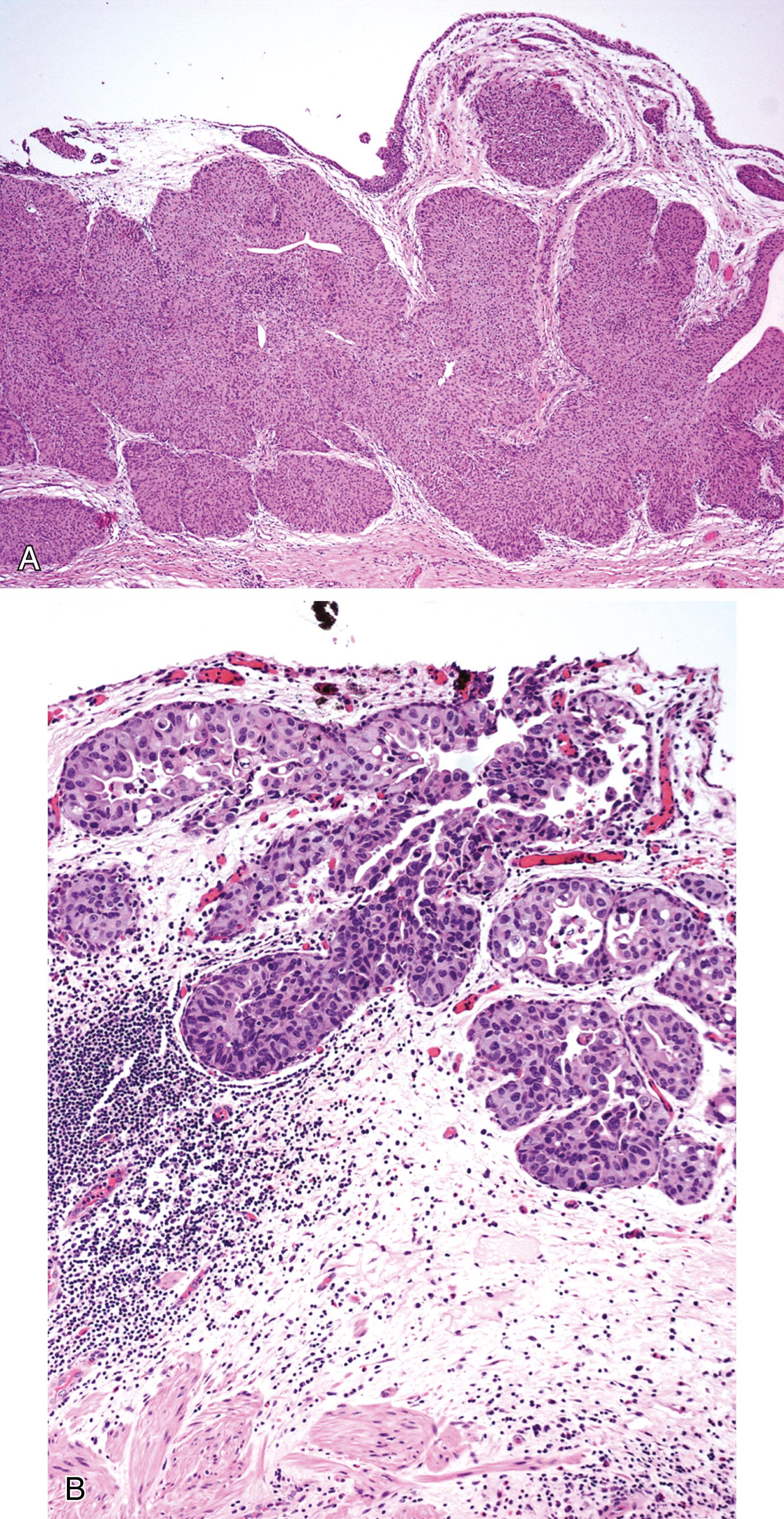
Mitoses are infrequent
May lack a distinct papillary architecture, although papillary remnants may persist
The papillae are frequently fused and branching
The pattern of disorder is predominant with easily recognizable variations in architectural and cytologic features
Cells are large and irregular with a spectrum of nuclear pleomorphism ranging from moderate to marked; nucleoli may be prominent ( Figure 10.1B )
Bizarre or multinucleated tumor cells may be seen
High mitotic activity; numerous atypical forms often seen
Usually infiltrates the underlying subepithelial connective tissue or muscularis propria and grows in solid cords or nests
Reactive desmoplastic stroma surrounds infiltrating nests of tumor cells
Squamous differentiation is seen in more than 20% of cases
Cytokeratin (high molecular weight and CK7), GATA3, and p63: positive
Carcinoembryonic antigen (CEA): positive (especially in high-grade tumors); PAX8 positive in a small percentage of cases
Cytogenetic studies: similar findings as in urothelial carcinoma of the bladder
Urothelial cords and trabeculae with uniform thickness, peripheral palisading, and central spindling and streaming
Minimal cytologic atypia and low mitotic activity
Lacks invasion into the muscularis propria
Typically solitary with a short, thin stalk
Consists of a polyp of loose fibroconnective and fibrovascular tissue covered by normal-appearing urothelium
Urine cytology is helpful for evaluating ureteral lesions
Prognosis is related to tumor stage (depth of invasion), grade (morphologic and cytologic features), and multifocality (presence of synchronous tumor in the renal pelvis)
Infectious cystitis can be caused by various microorganisms, including bacteria, fungi, viruses, and parasites
Diagnosis relies primarily on urinalysis, urine culture, and empirical antimicrobial therapy
Inflammatory condition caused by impaired intraphagosomal digestion
Most commonly found in the bladder; may be seen in the ureter, renal pelvis, testis, gynecologic tract, gastrointestinal tract, and lung
Typically found in women; peak incidence in fifth decade
Rarely seen in children
Most patients present with typical symptoms of urinary tract infection
Often culture Escherichia coli or other bacteria from the urine
Multiple, soft, yellow-white, nodular plaques measuring less than 2 cm
Involves mucosal surface
Accumulation of histiocytes with abundant eosinophilic granular cytoplasm (von Hansemann histiocytes) in the superficial lamina propria, typically underlying an intact urothelial layer ( Figure 10.2 )
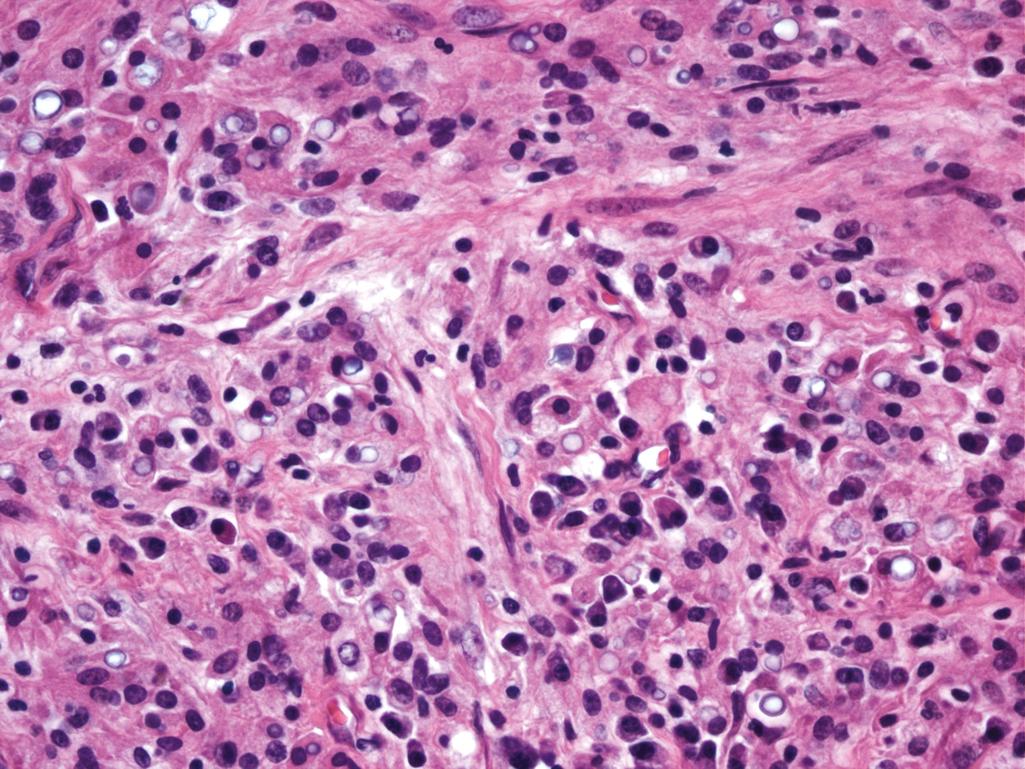
Michaelis-Gutmann bodies (small round basophilic intracytoplasmic or extracytoplasmic laminated structures with a bull’s eye appearance) are found within histiocytes as well as within the interstitium
Michaelis-Gutmann bodies are formed by precipitation of calcium or iron on bacteria or bacterial fragments
Extensive fibrosis or marked acute and chronic inflammation may be seen
Von Kossa calcium and Perl’s Prussian blue: Michaelis-Gutmann bodies are positive
Periodic acid-Schiff (PAS): Von Hansemann and Michaelis-Gutmann bodies are positive
Electron microscopy: Michaelis-Gutmann bodies consist of a dense core surrounded by a homogeneous zone composed of myelin figures; measure 5 to 10 μm in diameter
Lacks Michaelis-Gutmann bodies
Histiocytes are positive for CD1a and S-100
Terminology derived from the Greek words plakos (plaque) and malakos (soft)
Believed to result from impairment of the ability of mononuclear cells to degrade phagocytosed bacteria
Must identify Michaelis-Gutmann bodies in order to make the diagnosis
Patients may present with urinary frequency, urgency, or dysuria
Polypoid cystitis is often seen in patients with indwelling bladder catheters
Follicular cystitis is frequently seen in patients with bladder carcinoma and urinary tract infection
Giant cell cystitis is not a clinical entity; rather, it is a term used to describe the presence of atypical stromal cells in the lamina propria of the bladder
Occasionally seen following radiation treatment
Small polypoid mucosal lesions (may mimic bladder carcinoma)
Mucosa showing erythematous gray-white nodules
Usually a subtle finding; erythematous bladder mucosa may be seen
Broad fronds covered by benign-appearing urothelial cells
Lamina propria is edematous with chronic inflammation and congested blood vessels
Lamina propria contains scattered lymphoid follicles, usually with germinal centers
Atypical large stromal cells with bipolar or multipolar tapering eosinophilic processes and enlarged hyperchromatic nuclei (degenerative atypia); cells often contain multiple nuclei; mitoses are absent or rare ( Figure 10.3 )
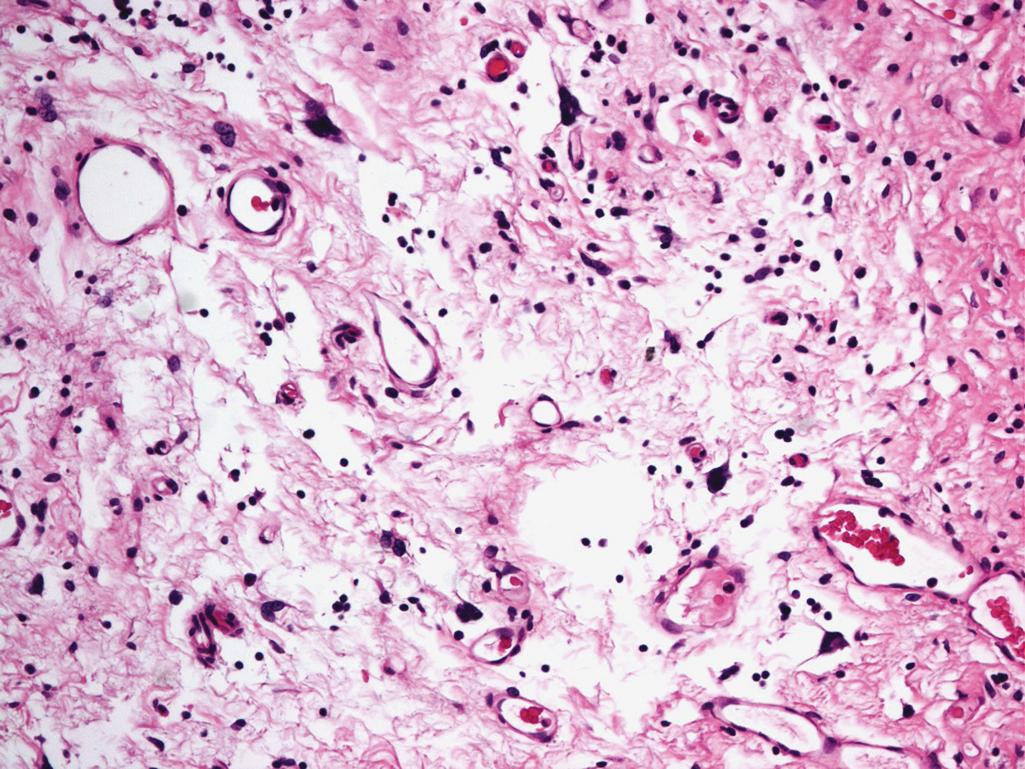
Noncontributory
Noncontributory
Inflammatory component consists of acute inflammatory cells
Bladder culture may yield positive results
May be confused with polypoid cystitis
Typically shows branching delicate papillae rather than broad fronds
Papillae are covered by atypical urothelial cells, which is much more pronounced than that seen in polypoid cystitis
Must be distinguished from follicular cystitis
Lymphomatous infiltrate typically shows a diffuse rather than follicular architecture
Must be distinguished from giant cell cystitis
Sarcomatous stromal cells have a higher degree of nuclear atypia; mitoses are commonly found
Removal of the irritant (catheter, toxin) typically resolves the cystitis
Often these conditions are asymptomatic and found incidentally
Bacillus Calmette-Guerin (BCG) cystitis is associated with intravesical instillation of BCG used in the treatment of urothelial carcinoma in situ (CIS) and HG-UC
Radiation cystitis may be acute or chronic and can occur whenever the bladder is included in the treatment field
Hemorrhagic cystitis is associated with radiation and chemotherapy; also seen with various chemical toxins (cyclophosphamide, busulfan) and viral infection (adenovirus in children), or may be idiopathic
Partially or entirely denuded bladder mucosa
Hyperemic and edematous bladder mucosa with thickened mucosal folds
Hemorrhagic and edematous bladder mucosa
Superficial lamina propria shows discrete noncaseating granulomas containing epithelioid histiocytes and multinucleated giant cells
Granulomas are associated with intense lymphocytic infiltrate
Urothelium may show nonspecific reactive atypia or be denuded
Lamina propria shows edema, hyperemia, and dilated blood vessels with fibrin ( Figure 10.4 )
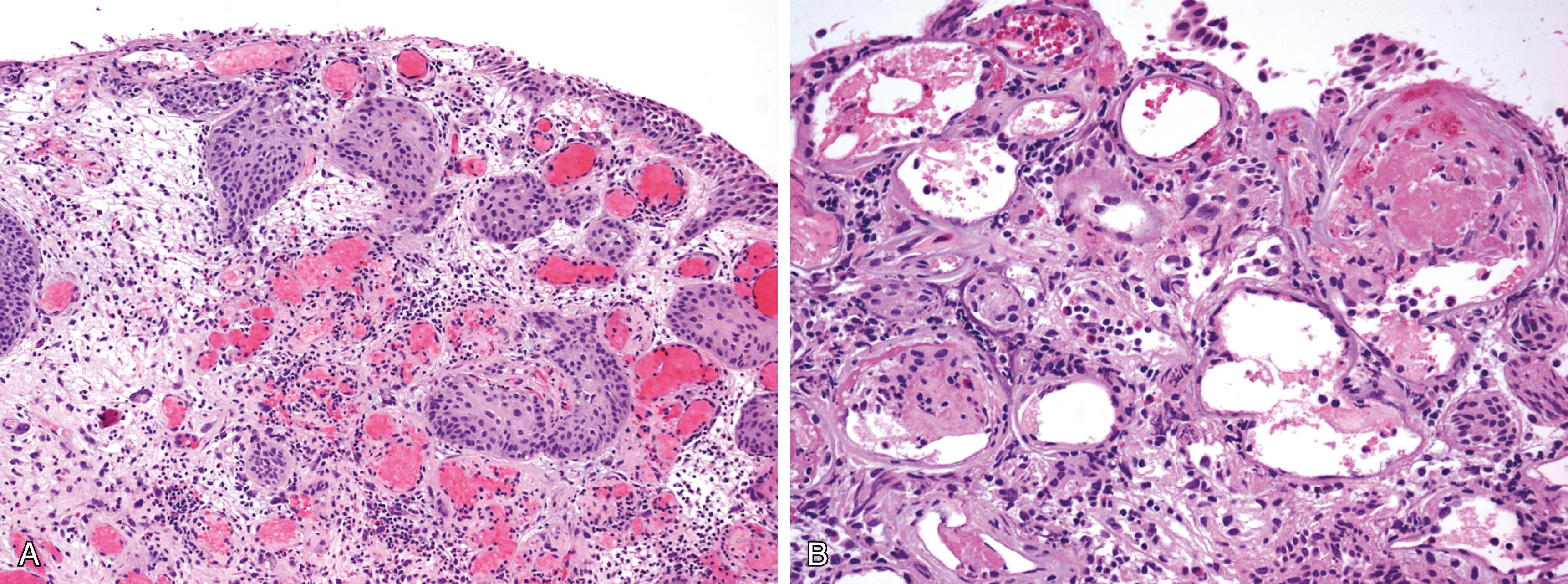
Proliferation of urothelial nests within lamina propria “hugging” ectatic vessels
Surface urothelium may shows desquamation, superficial ulceration, and atypical cytologic features mimicking CIS; however, atypia is degenerative and nuclear-cytoplasmic (N:C) ratio is low
Bizarre giant cells and multinucleated cells are often present
The stroma contains extravasated erythrocytes, inflammation, and hemosiderin deposition
Late changes include collagenization of the lamina propria, myointimal proliferation or hyalinization of the arteriole’s media, and often ulceration with fibrinous exudate
Lamina propria shows hemorrhage and congested blood vessels
Urothelium shows regenerative changes including nuclear pleomorphism
Healing may result in hyperplastic urothelium with papillae formation
Repeated bouts may result in a fibrotic, contracted bladder
Acid-fast stain rarely reveals the presence of microorganisms in BCG cystitis
Noncontributory
Inflammatory component consists of acute inflammatory cells
Bladder culture may yield positive results
Cytologic atypia and architectural distortion are more pronounced and mitoses are frequently found
Acute symptoms of radiation cystitis may appear 4 to 6 weeks after the initiation of treatment; late symptoms appear as late as 10 years later
Pathologist must be aware that these changes may be seen with a remote radiation or chemotherapy history
Accurate clinical history is key to avoid misdiagnosis
Classically occurs in middle-aged and elderly women
Interstitial cystitis is manifested by sensory hypersensitivity; patients present with urinary frequency, urgency, nocturia, suprapubic pressure, and pelvic and bladder pain
Hematuria may be seen
Urine is sterile and thus bladder culture is negative
Cystoscopy may show petechial hemorrhage after inflation (glomerulation) and small linear ulcerations in the mucosa (Hunner ulcer)
Scarring of bladder mucosa is often noted
Longstanding cases may result in a fibrotic, contracted bladder with markedly diminished capacity
Usually affects dome and posterolateral bladder walls
Multiple microhemorrhages are present within the lamina propria (glomerulations)
Classic phase (Hunner ulcer)
Single or multiple patches of reddened, ulcerated, or denuded bladder mucosa with fibrinous exudate often seen admixed with chronic inflammatory cells, including lymphocytes, plasma cells, and mast cells
Characteristic feature is increase in mast cells within the mucosa, lamina propria, and muscularis propria
Hemorrhage, edema, congestion, and fibrosis are also seen
Occasionally there is no ulceration of the mucosa; only chronic inflammation, edema, hemorrhage, and granulation tissue are seen
Noncontributory
Noncontributory
Denuding CIS exhibits ulceration, vascular congestion, and inflammation resembling interstitial cystitis
Multiple tissue sections should be examined to search for atypical cells
Inflammatory component consists of acute inflammatory cells
No increase in mast cells
Bladder culture may yield positive results
Features of polypoid cystitis, follicular cystitis, giant cell cystitis, or hemorrhagic cystitis
No increase in mast cells
Only nonspecific features exist and must be correlated with clinical impression; no pathognomonic microscopic features currently exist
Exclude CIS before a diagnosis of interstitial cystitis is rendered
Common non-neoplastic lesion of the bladder
Believed to be induced by chronic inflammatory stimulus
Found most commonly in adults; occasionally seen in children
Cystoscopically may occasionally mimic carcinoma
Small submucosal cysts filled with clear yellow fluid
May not always be grossly visible
Occasionally see irregular nodular mucosa
Von Brunn nests within the lamina propria showing central cystic dilatation with spaces lined by urothelial or low cuboidal epithelium ( Figure 10.5 )
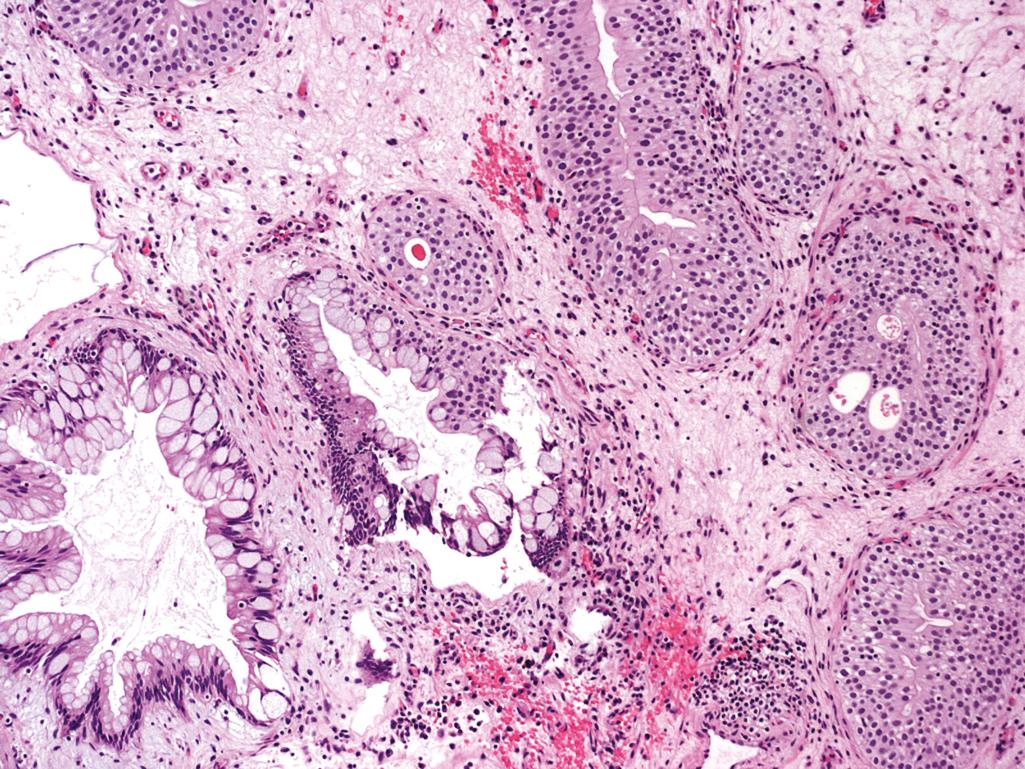
Cysts are often filled with pale eosinophilic fluid
The epithelial lining of von Brunn nests undergoes glandular metaplasia
Glands are lined by cuboidal to columnar cells without anaplasia
Cells may contain mucin and occasionally goblet cells are present
If the epithelium acquires intestinal-type goblet cells, this variant is called cystitis glandularis with intestinal metaplasia (if diffuse without urothelial cells: colonic metaplasia)
Reactive urothelium shows CK20 immunoreactivity in only the umbrella cell layer
p53 nuclear staining is predominantly negative with occasional weak positivity in the basal and parabasal intermediate cells
CD44 can be overexpressed in the entire reactive urothelium or focally positive in intermediate cells
Noncontributory
Florid von Brunn nest can be differentiated from nested variant of urothelial carcinoma by its lobular or linear array of the nests, flat noninfiltrative base, and lack of cytologic atypia
Rare bladder neoplasm
Atypical glands lined by stratified, pleomorphic cells with infiltration into the muscular layer
Signet ring cells may be seen
Florid von Brunn nests, cystitis cystica, and cystitis glandularis are closely related reactive changes that may be seen in any portion of the urothelial tract
Cystitis cystica et glandularis has no direct association with bladder cancer; coincidental coexistence may be seen
Cystitis glandularis may be confused with adenocarcinoma, especially if extravasated mucin is present
Believed to be associated with chronically irritated bladders; may resolve if source of inflammation is removed
Most cases involve the bladder; occasionally found in the urethra, ureter, or renal pelvis
Found in young adults with a male predominance (2:1)
Approximately half of the cases are found following genitourinary surgery, including renal transplantation
Also associated with calculi, trauma, and cystitis
Often asymptomatic, although patients frequently present with hematuria or dysuria
Usually found over the posterior bladder wall
May present as a papillary or polypoid exophytic mass or velvety lesion
Sessile forms comprise approximately 25% to 30% of cases
Papillary structures usually measure less than 1 cm; may rarely measure greater than 5 cm
Classic histologic pattern is that of small tubules resembling renal tubules ( Figure 10.6A )
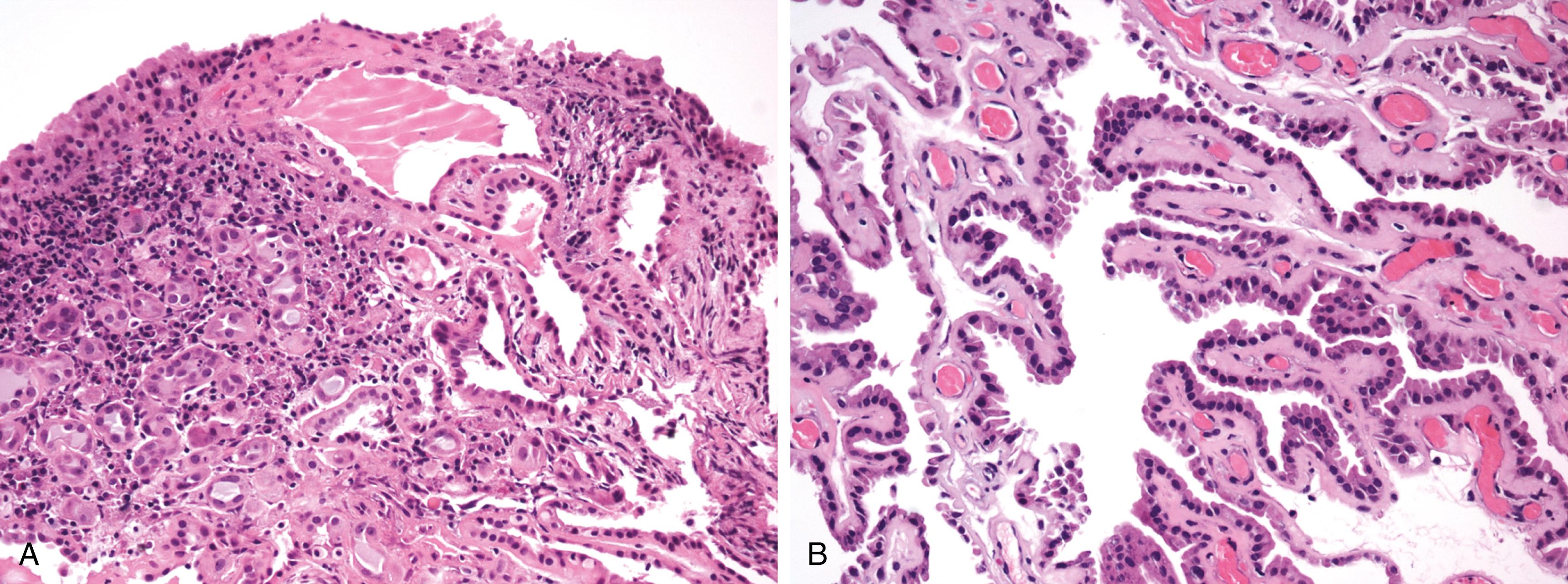
May also see papillary or flat architecture
Tubules are lined by “hobnail” cells resembling endothelial-lined vascular spaces ( Figure 10.6B )
Tubules are often surrounded by a layer of hyalinized basement membrane
Cells with oxyphilic or clear cytoplasm, or signet-ring–like cells, may also be seen
Mitotic activity is rare
Pale eosinophilic secretions are often found within the tubules
A variable degree of acute and chronic inflammation and stromal edema are common in the background
Typically confined to the lamina propria, it can on occasion focally involve the superficial lamina propria; rarely may have a deep infiltrative pattern into perinephric adipose tissue
Cytokeratin 7 (CK7), PAX2, and PAX8 are positive in the tubular lining cells
Focal and weak prostate-specific antigen (PSA) and PAP expression is detected in a subset of cases
Most cases are positive for AMACR and negative for high molecular weight cytokeratin (34BE12)
Noncontributory
Not typically associated with other clinical conditions
Tubules with prominent nucleoli sometimes situated within muscle bundles
Usually much larger
Shows greater cytologic atypia and high mitotic rate
Papillae are covered by neoplastic urothelial cells rather than benign-appearing cuboidal cells
Nested or microcystic variant of urothelial carcinoma exhibits greater atypia and increased mitoses at the deep invasive fronts
Negative for CK7 and positive for endothelial markers, such as CD31
Evidence in renal transplant patients suggests that nephrogenic adenoma is derived from tubular renal cells and is not a metaplastic proliferation of the urothelium
In 1998, the WHO/ISUP published a consensus classification. The following entities were included in the category for flat urinary bladder lesions: flat urothelial hyperplasia and flat lesion with atypia, which is further divided into reactive atypia, atypia of unknown significance, urothelial dysplasia (low-grade intraepithelial neoplasia), and flat urothelial CIS (high-grade intraepithelial neoplasia). Because the 2003 WHO has accepted the nomenclature used in 1998, the system is currently referred to as WHO (2003)/ISUP.
Rare benign urothelial lesion; it may be seen in the flat mucosa adjacent to a low-grade papillary urothelial lesion
Noncontributory
Markedly thickened urothelial mucosa without cytologic atypia
Rather than requiring a specific number of cell layers, marked thickening compared with the adjacent normal urothelium is needed to diagnosis flat hyperplasia
Noncontributory
Frequent deletions of chromosome 9 detected by fluorescence in situ hybridization (FISH) have been reported in urothelial hyperplasias found in patients with papillary bladder cancer
Variable, often appreciable, loss of cell polarity with nuclear crowding and cytologic atypia that is not severe enough to merit a diagnosis of CIS
Pleomorphism, prominent nucleoli throughout the urothelium and upper-level mitoses
Regarded in the new WHO classification as a lesion without malignant potential
Molecular analysis has shown that urothelial hyperplasia in bladder cancer patients may be chronologically related to papillary tumors
In the absence of an associated papillary urothelial neoplasm, no treatment or follow-up is required
De novo dysplasia affects predominantly middle-aged men presenting occasionally with irritative bladder symptoms with or without hematuria
Lesion may be inapparent or associated with erythema, erosion, or (rarely) ulceration
Shows variable, often appreciable, loss of cell polarity, with nuclear crowding and cytologic atypia, that is not severe enough to merit a diagnosis of CIS ( Figure 10.7 )
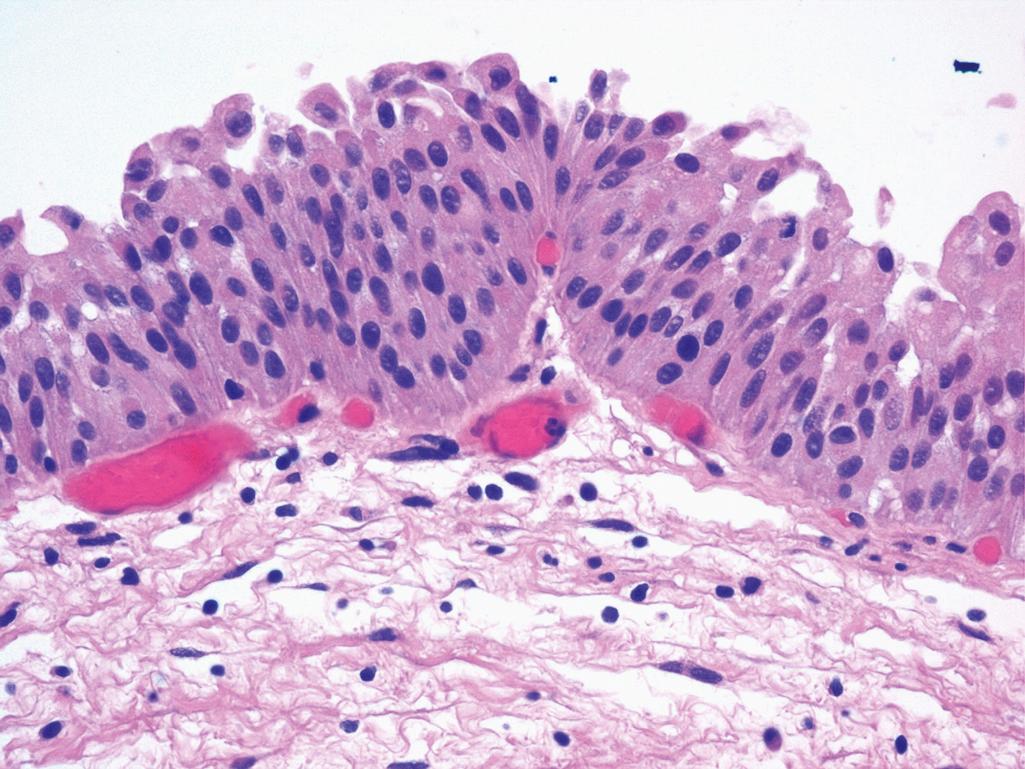
Cells may have mildly altered chromatin distribution, slightly enlarged nuclei, inconspicuous nucleoli, and rare mitoses
The thickness of the urothelium is usually normal; however, it may be increased or decreased
Lamina propria may contain increased inflammation or neovascularity
Urothelial dysplasia may involve von Brunn nests
Aberrant CK20 expression
p53 and Ki-67 overexpression
Alteration of chromosome 9 and p53 allelic losses have been demonstrated
Typically shows pleomorphism, and prominent nucleoli throughout the urothelium
Increased mitotic activity with upper-level mitosis
Coarse chromatin pattern
Presence of acute and chronic inflammation
Presence of significant atypia and significant inflammation
Dysplasia in patients with noninvasive papillary neoplasms indicates urothelial instability and a marker for progression or recurrence
De novo dysplasia progresses to urothelial neoplasia in 5% to 19% of patients
Amin MB, McKenney JK. An approach to the diagnosis of flat intraepithelial lesions of the urinary bladder using the World Health Organization/International Society of Urological Pathology consensus classification system. Adv Anat Pathol. 2002;9:222–232.
Hodges KB, Lopez-Beltran A, Davidson DD, et al. Urothelial dysplasia and other flat lesions of the urinary bladder: clinicopathologic and molecular features. Hum Pathol. 2010;41:155–162.
Patients are usually in their fifth to sixth decade
Asymptomatic or symptomatic with dysuria, frequency, urgency, or even hematuria
CIS is commonly multifocal and may be diffuse
De novo (primary) CIS accounts for less than 1% to 3% of urothelial neoplasms but is seen in association with 45% to 65% of invasive urothelial carcinomas
Bladder mucosa may be unremarkable or erythematous and edematous
Urothelial CIS is a nonpapillary (i.e., flat) lesion in which the surface epithelium contains cytologically malignant cells ( Figure 10.8 )
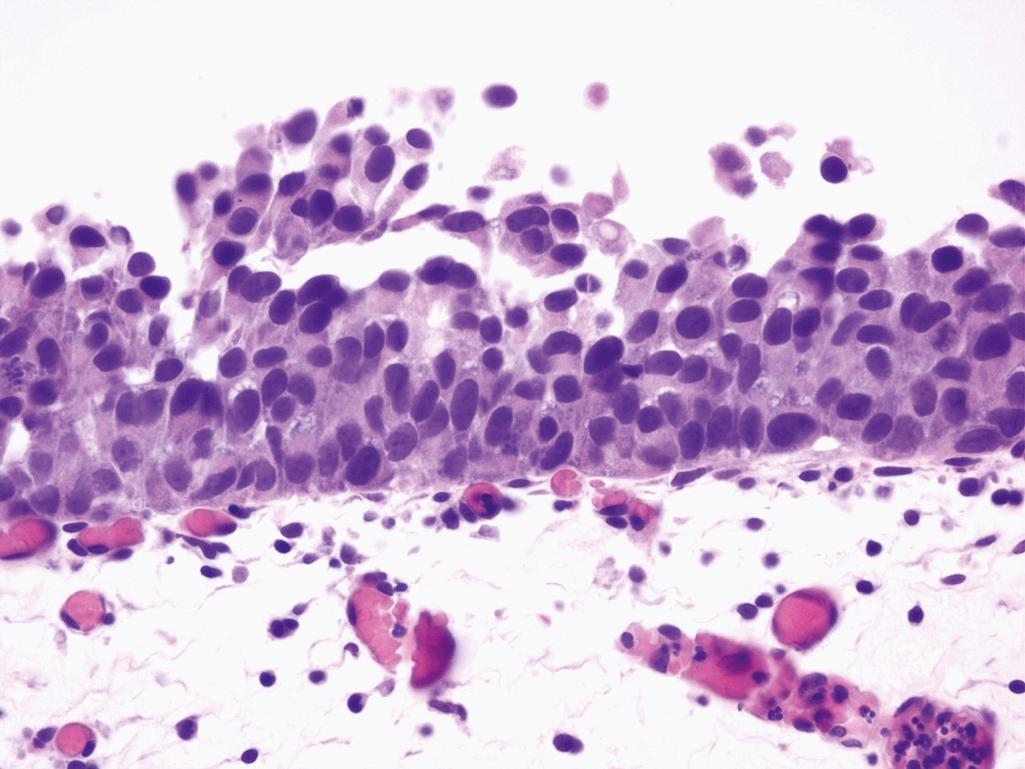
The term CIS is synonymous with “high-grade intraurothelial neoplasia”
Nuclear anaplasia identical to HG-UC
The urothelium may be denuded, diminished in thickness, of normal thickness, or even hyperplastic
There may be complete loss of polarity, marked crowding, and pleomorphism
Nuclei are frequently hyperchromatic and have a coarse or condensed chromatin distribution
CK20: diffuse strong cytoplasmic staining involving the full thickness of urothelium
p53: nuclear staining may be diffuse throughout the full thickness
CD44: expression limited to residual basal cell layer or negative
Chromosome 9 deletions and p53 allelic losses have been frequently demonstrated
Cytologic atypia is not severe enough to merit a diagnosis of CIS
Lacks pleomorphism comparable to high-grade papillary carcinoma, discohesion, or mitoses in the upper urothelium
Lacks nuclear pleomorphism
Presence of acute and chronic inflammation
Presence of significant atypia and significant inflammation
Florid epithelial proliferation with cell enlargement, hyperchromasia, and prominent nucleoli
Stromal fibrosis, subepithelial hemorrhage, and hyalinization of blood vessels
Nucleomegaly, high N:C ratio, and hyperchromasia
Homogeneous, smudgy, basophilic, opaque nuclear inclusion
Smooth nuclear membranes; nucleoli are absent
De novo CIS is less likely to progress to invasive disease than is secondary CIS
BCG immunotherapy remains the most effective treatment and prophylaxis for CIS, reducing short-term tumor recurrence by about 20% and long-term recurrence by about 7%; however disease progression, and mortality are not significantly reduced
Oliva E, Pinheiro NF, Heney NM, et al. Immunohistochemistry as an adjunct in the differential diagnosis of radiation-induced atypia versus urothelial carcinoma in situ of the bladder: a study of 45 cases. Hum Pathol . 2013;44:860–866.
Yin H, He Q, Li T, Leong AS. Cytokeratin 20 and Ki-67 to distinguish carcinoma in situ from flat non-neoplastic urothelium. Appl Immunohistochem Mol Morphol . 2006;14:260–265.
The WHO (2003)/ISUP classification of noninvasive papillary urothelial lesions comprises papillary hyperplasia, urothelial papilloma and inverted papilloma, papillary neoplasm of low malignant potential, and low-grade (LG) and HG-UC. To avoid an intermediate cancer grade group (grade II), the WHO (2003)/ISUP system classifies papillary urothelial carcinoma into only two grades: LG-UC and HG-UC.
Typically discovered on routine follow-up cystoscopy for papillary urothelial neoplasms
Benign focally elevated lesion identified at cystoscopy, described as papillary, raised, sessile, or bleblike
Undulating urothelium arranged into mucosal narrow papillary folds of varying heights; no detached papillary fronds
The urothelium within papillary hyperplasia and the adjacent flat mucosa are often thicker than normal
The cytologic findings are similar to those characteristic of normal urothelium
Noncontributory
Noncontributory
Well-developed, detached papillary fronds with branching fibrovascular cores of a papillary neoplasm are evident
Patients should be followed, as papillary hyperplasia likely represents the precursor lesion to low-grade papillary urothelial neoplasms
Benign papillary urothelial tumor lined by normal-appearing urothelium
Slightly more common in men
Tends to occur in younger patients and is seen in children
Usually presents with gross hematuria
Urothelial papillomas typically have a simple papillary architecture
Papillary fronds are lined by normal-appearing urothelium, lacking atypia ( Figure 10.9 )
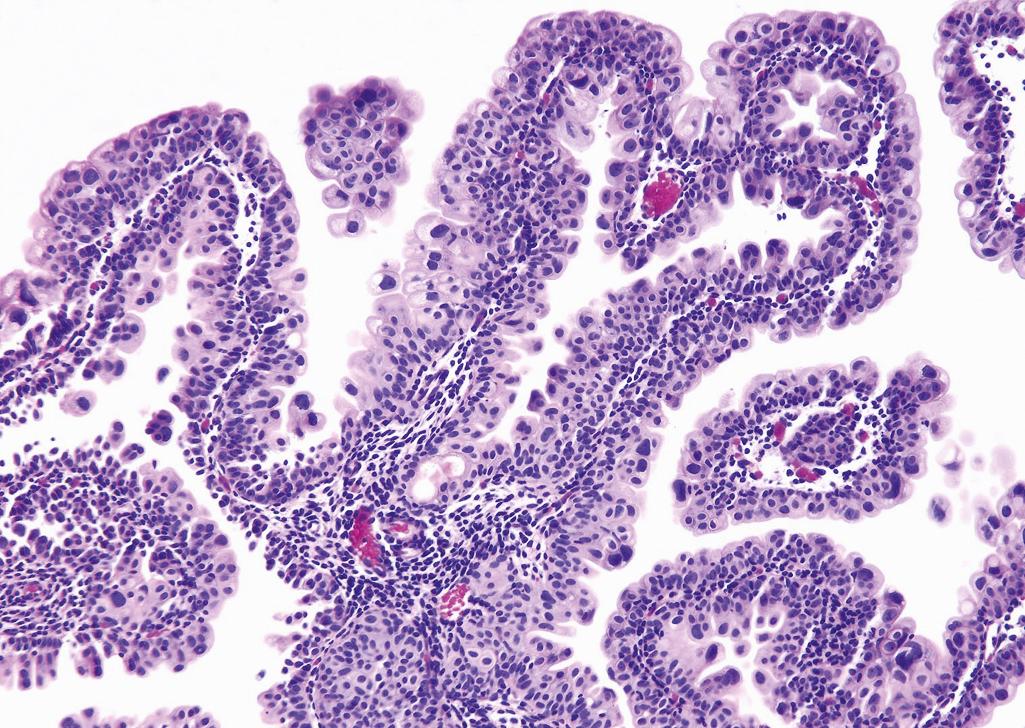
Usually have a simple minimally branching arrangement and slender fibrovascular stalks with a predominantly exophytic pattern
Superficial umbrella cells are often prominent, with abundant eosinophilic cytoplasm, and vacuolization
Mitoses are absent
Cytokeratin 20: confined to the umbrella cells, similarly to normal urothelium
Noncontributory
Markedly thickened urothelium
Mitoses may be present but are confined to the basal layers
Rarely recur; can progress to higher-grade disease
Complete transurethral resection is the treatment of choice
Magi-Galluzzi C, Epstein JI. Urothelial papilloma of the bladder: a review of 34 de novo cases. Am J Surg Pathol . 2004;28:1615–1620.
McKenney JK, Amin MB, Young RH. Urothelial (transitional cell) papilloma of the urinary bladder: a clinicopathologic study of 26 cases. Mod Pathol . 2003;16:623–629.
Rare benign urothelial tumor of unknown etiology
More common in males and occurs at all ages; median age is 55 years
Typically involves the bladder at the trigone, bladder neck, or prostatic urethra
Frequently presents with hematuria
Typically solitary flat or slightly raised polypoid mass with smooth contours
Usually minimal exophytic component
Most are smaller than 3 cm in diameter
Characterized by anastomosing cords or islands of urothelium showing uniform width and minimal cytologic atypia; rare mitotic activity ( Figure 10.10A )
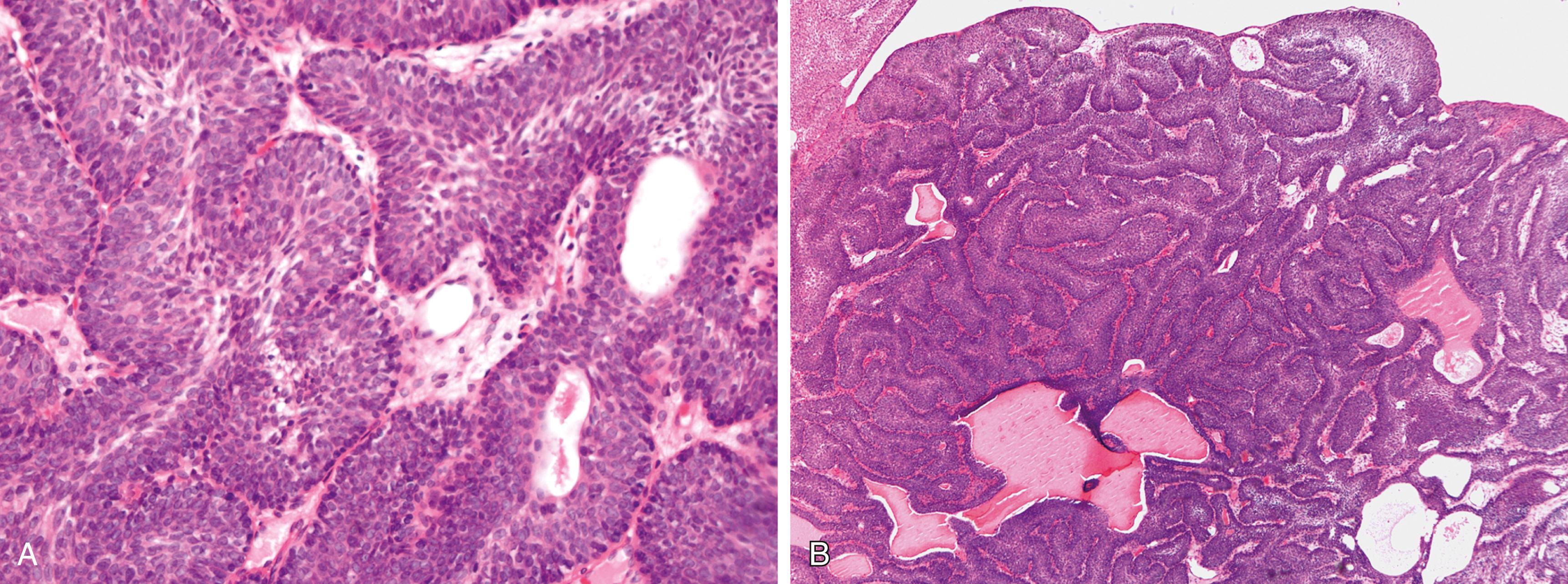
Tumor originates from the surface urothelium and extends down into the underlying lamina propria but not into the muscular bladder wall ( Figure 10.10B )
Small cystic spaces and true glandular differentiation with layer of mucin secreting cells may be seen
The stromal component is mostly minimal and lacks inflammation
Noncontributory
Noncontributory
Typically shows an exophytic papillary architecture
Increased cytologic atypia and increased mitotic activity
Invasive growth pattern is often noted
Round nests without the anastomosing pattern
Relationship between inverted papilloma and low-grade papillary urothelial carcinoma is not fully understood
Inverted papilloma is best treated by transurethral resection; occasional recurrences have been reported
Occasionally coexistence with papillary urothelial carcinoma has been described, although it is unresolved whether there is an increased risk of this relationship
Patel P, Reikie BA, Maxwell JP, et al. Long-term clinical outcome of inverted urothelial papilloma including cases with focal papillary pattern: is continuous surveillance necessary? Urology . 2013;82:857–860.
Sung MT, MacLennan GT, Lopez-Beltran A, et al. Natural history of urothelial inverted papilloma. Cancer . 2006;107:2622–2627.
Papillary urothelial neoplasm lined by urothelium with minimal atypia
Slightly more common in men
Mean age at diagnosis is 64.6 years (ranges from 29 to 94 years)
Usually presents with gross or microscopic hematuria
Small to 2-cm papillary tumor
Discrete and slender papillary fronds lined by a thickened multilayered urothelium with minimal to absent cytologic atypia ( Figure 10.11 )
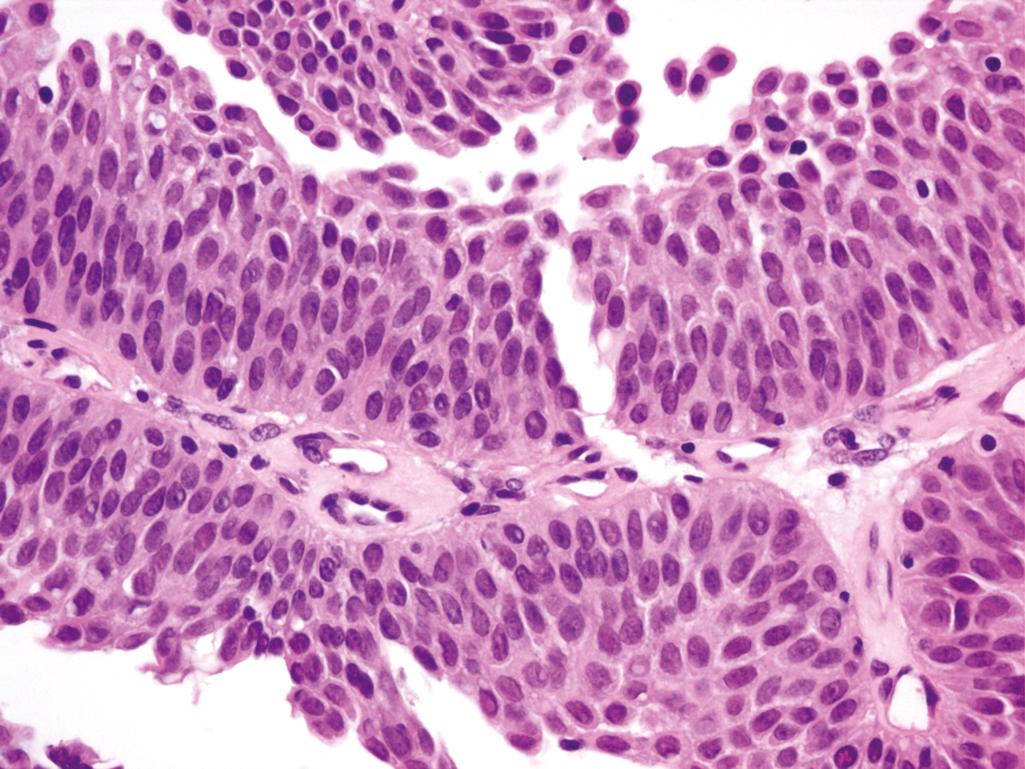
Cell density appears to be increased compared to normal
Polarity is preserved
Mitoses are rare and have a basal location
Cytokeratin 20: confined to the umbrella cells
Noncontributory
Scattered cells with enlarged hyperchromatic nuclei
More than rare mitotic figures
Lining urothelium is of normal thickness
Recurrences occur but at a lower frequency than with papillary carcinoma
Transurethral resection is the treatment of choice
Jones TD, Cheng L. Papillary urothelial neoplasm of low malignant potential: evolving terminology and concepts. J Urol . 2006; 175:1995–2003.
Lee TK, Chaux A, Karram S, et al. Papillary urothelial neoplasm of low malignant potential of the urinary bladder: clinicopathologic and outcome analysis from a single academic center. Hum Pathol . 2011; 42:1799–1803.
Papillary neoplasm lined by urothelium with easily recognizable variation in architectural and cytologic features
Slightly more common in men
Mean age at diagnosis is 69.2 years (ranges from 28 to 90 years)
Usually presents with gross or microscopic hematuria
In the majority of the cases, the papillary tumor is single
Slender papillary fronds showing frequent branching and minimal fusion ( Figure 10.12 )
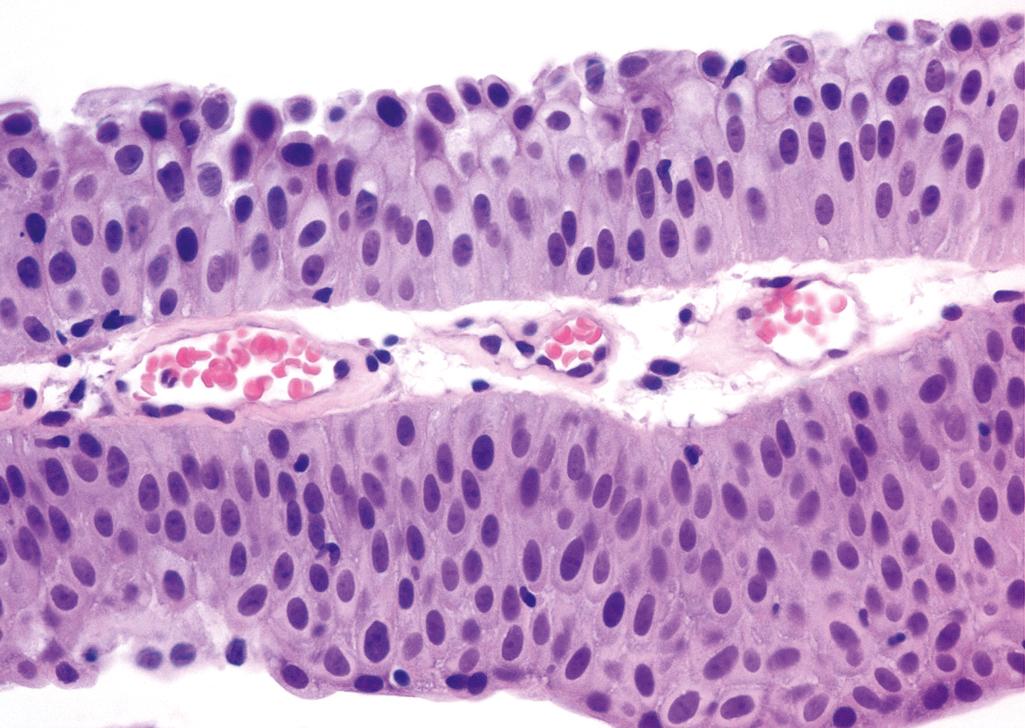
Lesion shows an orderly appearance with easily recognizable variations in architectural and cytologic features
Nuclei are uniformly enlarged with mild variation in shape, contour, and chromatin distribution
Mitoses are infrequent and may occur at any level
p53 and Ki-67 expression is intermediate between papillary urothelial neoplasm of low malignant potential and high-grade urothelial carcinoma
Negative or focal reactivity for CK20
Allelic loss of multiple chromosome loci has been reported
Monotonous bland-appearing cells, lacking scattered cells with enlarged hyperchromatic nuclei
High degree of cytologic atypia with architectural distortion
Recurrence is common in approximately 48% to 71% of patients
Progression to invasion and cancer deaths occurs in less than 5% of patients
Transurethral resection is the treatment of choice; multifocal or recurrent disease is sometimes treated with intravesical immunotherapy
Vardar E, Gunlusoy B, Minareci S, et al. Evaluation of p53 nuclear accumulation in low- and high-grade (WHO/ISUP classification) transitional papillary carcinomas of the bladder for tumor recurrence and progression. Urol Int . 2006;77:27–33.
Wu XR. Urothelial tumorigenesis: a tale of divergent pathways. Nat Rev Cancer . 2005;5:713–772.
Usually presents with gross or microscopic hematuria
Appearance varies from papillary to nodular/solid sessile lesion
Papillary neoplasm characterized by a disorderly appearance of urothelium resulting from marked architectural and cytologic abnormalities, recognizable at low magnification
Papillae are frequently fused and branching, although some may be delicate; extensive denudation may be present ( Figure 10.13 )
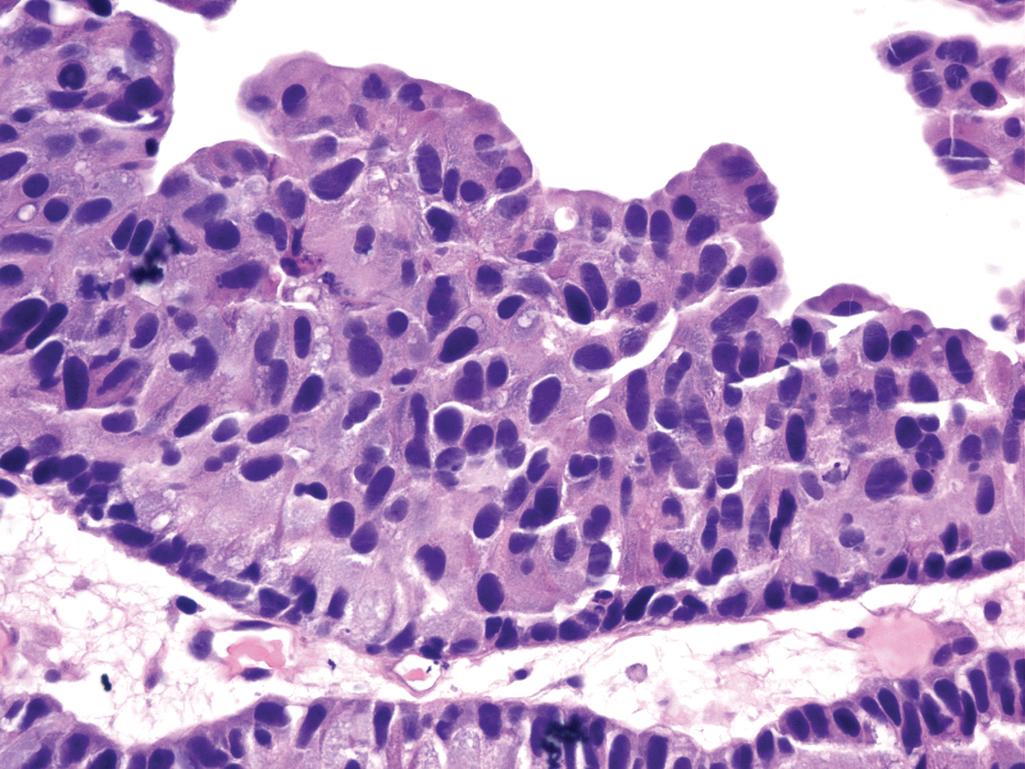
Cytologically, there is a spectrum of pleomorphism ranging from moderate to marked
There is marked variation in nuclear polarity, size, shape, and chromatin pattern; nucleoli may be prominent
Mitotic figures, including atypical forms, are frequently seen at all levels of the urothelium
Detection of p53 and ki67 is more frequent than in low-grade urothelial carcinoma
Strong and diffuse reactivity for p16 and CK20
Deletion of chromosome 9p seems to be an early event in the development of papillary urothelial carcinoma
Mild degree of cytologic atypia with minimum architectural distortion
Urothelial carcinoma with both low- and high-grade features is not uncommon
Invasion both within the papillary cores and at the base of the lesions should be ruled out
Chaux A, Karram S, Miller JS, et al. High-grade papillary urothelial carcinoma of the urinary tract: a clinicopathologic analysis of a post-World Health Organization/International Society of Urological Pathology classification cohort from a single academic center. Hum Pathol . 2012;43:115–120.
Mai KT, Flood TA, Williams P, et al. Mixed low- and high-grade papillary urothelial carcinoma: histopathogenetic and clinical significance. Virchows Arch . 2013;463:575–581.
Owens CL, Epstein JI. Significance of denuded urothelium in papillary urothelial lesions. Am J Surg Pathol . 2007;31:298–303.
Typically found in elderly individuals with a mean age older than 65 years
More frequently seen in men M:F = 3:1
Associated with tobacco smoking, many toxic chemicals (including nitrosamines), drugs (phenacetin, cyclophosphamide), infections ( Schistosoma hematobium )
Most common presenting symptom is painless hematuria
Patients may have flank pain and obstructive symptoms
Tumors usually involve the lateral or posterior bladder walls; occasionally involve the bladder dome
Low-grade tumors typically have a papillary architecture appearing as multiple finger-like fronds over the bladder mucosa (see Noninvasive LG-UC)
Higher-grade tumors often lack papillary architecture and show nodular, polypoid, or sessile pattern (see Noninvasive HG-UC); focal remnants of papillary architecture may persist
Bladder wall is typically thickened, firm, and gray-white
Ulceration and hemorrhage are often seen in the high-grade tumors
Foci of invasion are characterized by urothelial nests, clusters, or single cells within the papillary cores or lamina propria ( Figure 10.14 )
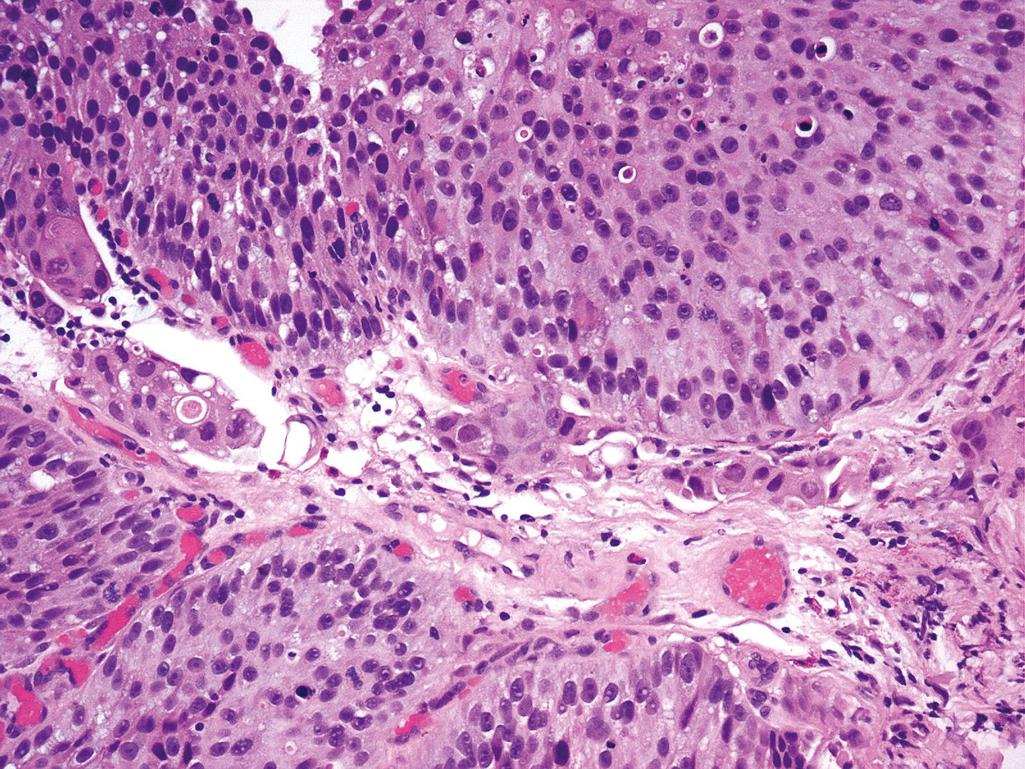
Reactive desmoplastic stroma surround infiltrating nests of tumor cells
Foci of invasive tumor may be associated with retraction artifact, mimicking vascular invasion
Usually nonpapillary tumors infiltrate the underlying muscularis propria
Muscularis propria invasion is diagnosed when carcinoma infiltrates between thick distinct fascicles of muscle bundles
Muscle invasion may or may not elicit a desmoplastic stromal response
Even in cases of noninvasive disease, the pathologist should note whether muscularis propria is present in the biopsy specimen
Adipose tissue is often present between detrusor muscle bundles, thus the presence of tumor in fat in a biopsy does not necessarily equate with involvement of perivesical fat
Urothelial carcinoma has a propensity for divergent differentiation with the most common being squamous followed by glandular
Presence of variant histology in general has no impact on clinical outcomes, although such tumors often have other adverse pathologic features such as higher stage
Occurs in 21% of urothelial carcinomas of the bladder and 44% of tumors of the renal pelvis
Clinical significance of squamous differentiation remains uncertain
Tubular or enteric glands with mucin secretions may be present in about 6% of urothelial carcinoma of the bladder
Aggressive neoplasm, with 70% of the patients dead 4 to 40 months after diagnosis, despite therapy
This variant has a deceptively benign appearance that closely resembles von Brunn nests infiltrating the lamina propria ( Figure 10.15 )
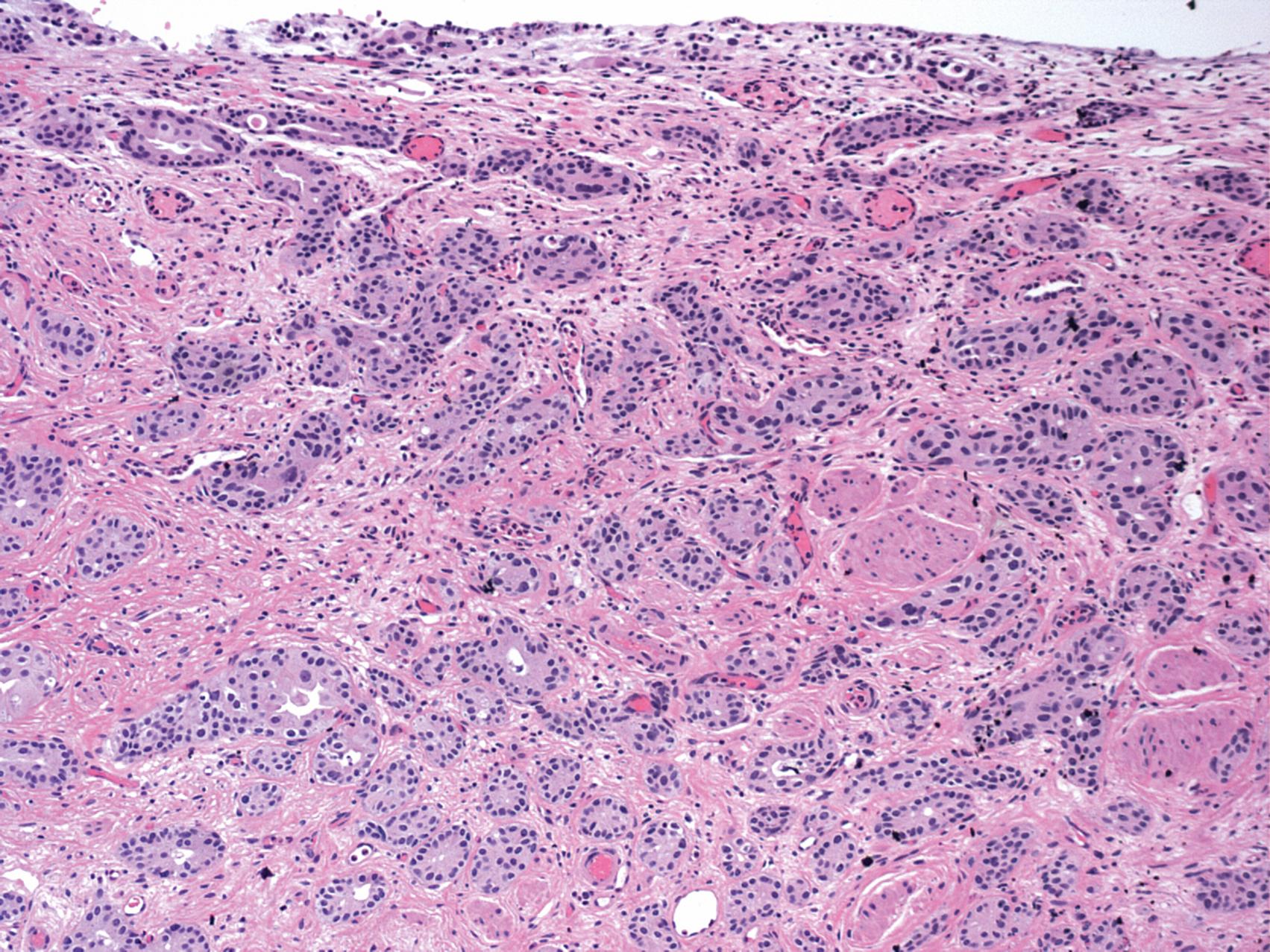
Contains unevenly distributed medium to large cell nests with rounded to irregular contours, typically separated by abundant fibrous stromal tissue ( Figure 10.16 )
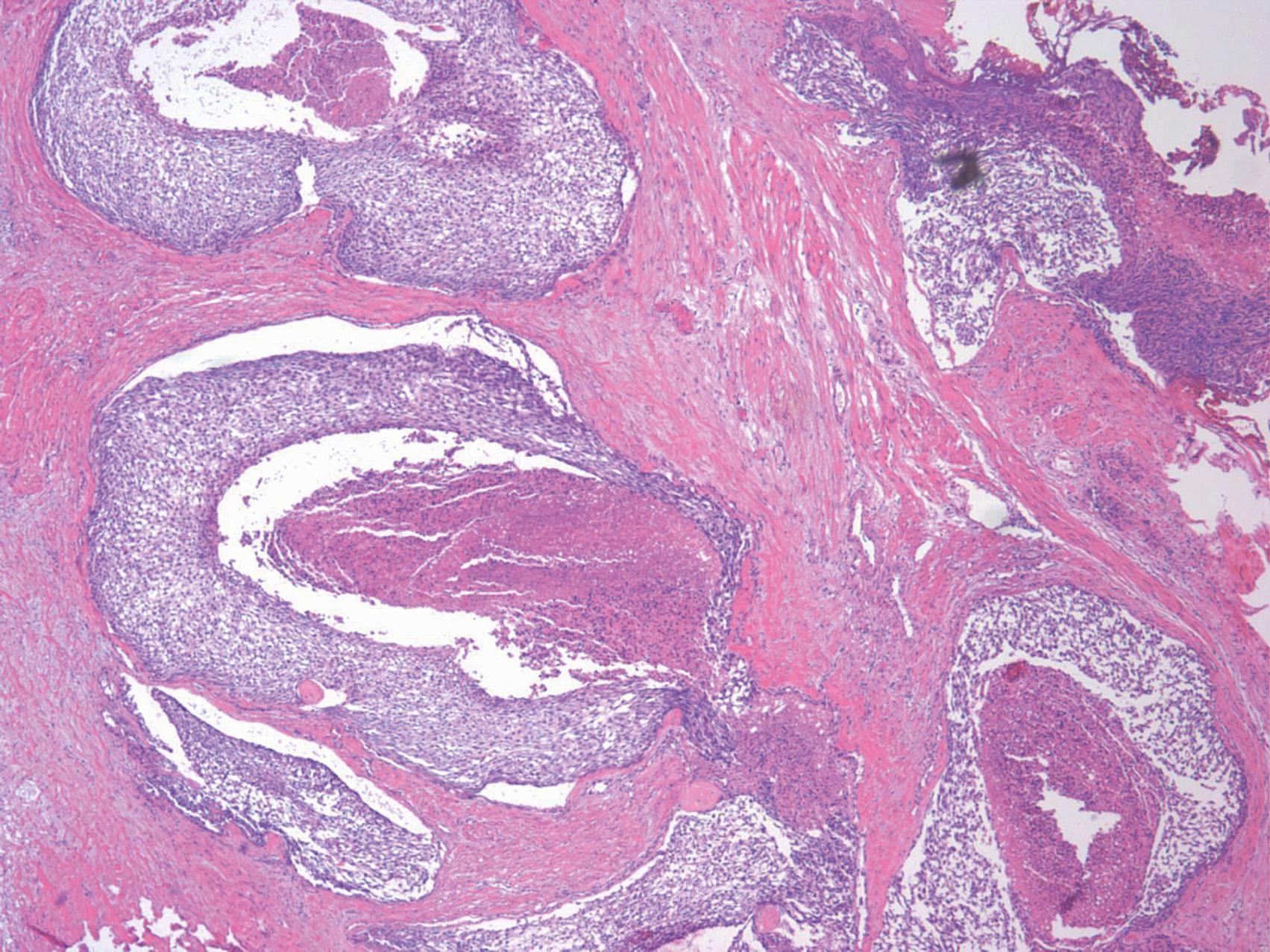
Displays deceptively bland cytologic features, often mimicking low-grade urothelial carcinoma
Tumors frequently have a surface component, often of LG-UC, although in rare cases there may be an associated high-grade papillary component
Invasion into the muscularis propria is commonly present with occasional cases displaying invasion into perivesical tissue
Resembles papillary serous carcinoma of the ovary
Surface of the tumors shows slender, delicate papillary and villiform processes, often without a central vascular core
Invasive portion is characterized by minute nests of cells or fine papillae contained within tissue retraction spaces, simulating lymphatic spaces
Tumors are invariably muscle invasive, high grade
Morphology is similar to lymphoepithelioma-like carcinoma in other organs with nests of tumor cells heavily infiltrated and masqueraded by lymphoplasmacytic cells
Proportion of lymphoepithelioma-like carcinoma should be reported
Behavior is uncertain as only few cases have been reported
Pure form of lymphoepithelioma-like carcinoma is responsive to chemotherapy
Cytokeratin (high molecular weight, CK7, CK20), p63, and CD15: positive
CEA: positive (especially in high-grade tumors)
GATA3: positive
Cytogenetic studies: deletion of chromosome 9p is associated with superficial disease; abnormalities involving chromosome 17p are associated with disease progression; aneuploidy involving chromosomes 3, 7, and 17
Must be distinguished from low-grade papillary transitional cell carcinoma
Usually shows wider papillary structures and stromal edema
Urothelium may show reactive atypia but usually less dysplasia than in transitional cell carcinoma
Must be distinguished from nested and large nested variants of urothelial carcinoma
Lobulated architecture with flat, noninvasive base
Urothelial nests of relatively uniform size and shape and often associated with cystitis cystica et glandularis
No significant cytologic atypia
Must be distinguished from glandular component of urothelial carcinoma with glandular differentiation
Classic histologic pattern is that of small tubules resembling renal tubules
Papillary architecture can be confused with urothelial carcinoma
Papillae and tubules are lined by benign cuboidal cells
PAX2 and PAX8 positive, P63 and GATA3 negative
Minimal cytologic atypia and low mitotic activity
Lacks invasion into the muscularis propria
Must be distinguished from large nested variant of urothelial carcinoma
Lacks invasive appearance and invasion into the muscularis propria
Has rounded nests, which are fairly uniform in size and usually crowded
Pure squamous lesions lacking in situ and invasive urothelial component
If an urothelial component is seen, the lesion should be classified as urothelial carcinoma with squamous differentiation
Must distinguish from lymphoepithelioma-like variant of urothelial carcinoma
Islands of high-grade epithelial cells are not seen
Cytokeratin is negative
Leukocyte common antigen (LCA) is diffusely positive
Must distinguish from poorly differentiated bladder cancer
Specimen is often obtained from the trigone or bladder neck
p63, GATA3, and thrombomodulin are negative
PSA, prostate-specific acid phosphatase (PSAP), prostate specific membrane antigen (PSMA), p501s (prostein), and NKX3.1 are positive
Urine cytology is a valuable tool for managing patients with bladder cancer, especially high grade (best used as monitor for therapeutic response)
Superficial urothelial tumors include those tumors that are confined to the lamina propria (stage T1); invasive cancer includes lesions that have invaded into the superficial muscularis propria (detrusor muscle) (stage T2a), deep muscularis propria (stage T2b), perivesical tissue (stage T3), and contiguous organs or tissues (stage T4)
Low-grade urothelial carcinoma when completely excised virtually never metastasizes
Despite the bland cytologic features, nested and large nested variants of urothelial carcinoma have well-documented metastatic potential
Pathologist must comment on whether the biopsy material contains muscularis propria (detrusor muscle) and also whether or not there is muscularis propria invasion
Superficial tumors have traditionally been treated with transurethral resection and intravesical chemotherapy or BCG, and muscle-invasive tumors have required radical cystectomy
Rare glandular neoplasm of the urinary bladder, which histologically mimics its enteric counterpart
The lesion occurs in elderly patients (mean age 65 years)
The most common locations are the urachus, dome, and trigone
Patients often present with hematuria or irritative symptoms, occasionally with mucosuria
Often coexists with in situ or invasive adenocarcinoma
Papillary tumor indistinguishable from papillary urothelial carcinoma
Blunt finger-like papillary architecture with central fibrovascular core, lined by pseudostratified columnar epithelium ( Figure 10.17A )
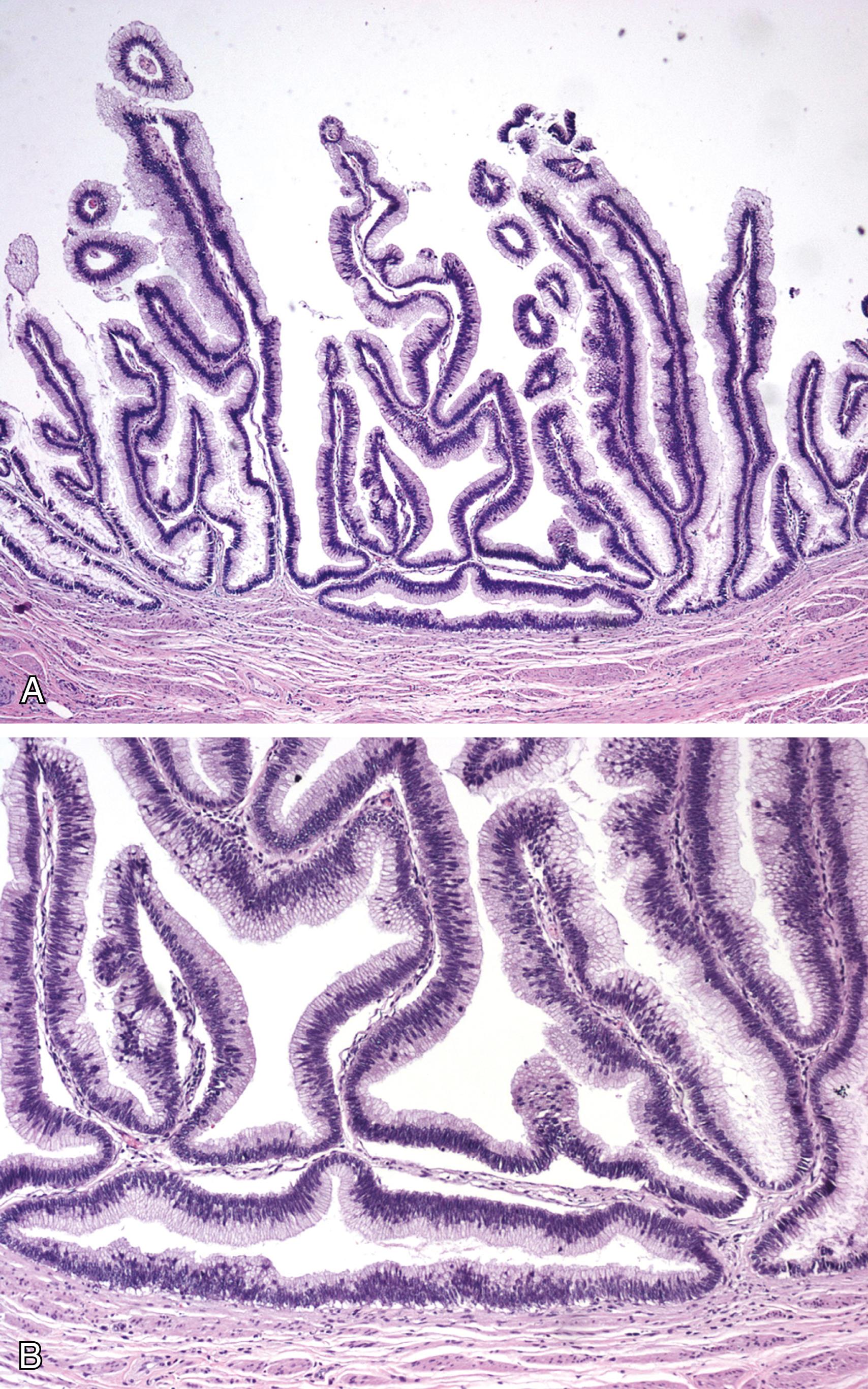
Epithelial cells display nuclear stratification, crowding, hyperchromasia, and occasional prominent nucleoli ( Figure 10.17B )
CK20, CK7 and CEA: positive
Epithelial membrane antigen (EMA) and acid mucin stains: frequently positive
Noncontributory
Degree of cytologic atypia similar to analogous colonic lesions
Invasion into lamina propria
Presence of villous adenoma histology in a limited biopsy does not entirely exclude the possibility of adenocarcinoma, and complete excision is essential
Rare bladder neoplasm comprising approximately less than 2% of all bladder tumors
Divided into two groups:
Nonurachal adenocarcinoma
Urachal adenocarcinoma
Accounts for two thirds of adenocarcinomas of the bladder
Found in adults with a mean age of 60 years
Most common presenting symptom is gross hematuria, followed by dysuria
Up to 40% of patients have metastatic disease at time of diagnosis
Occasionally associated with Schistosoma hematobium (less common association than with squamous cell carcinoma)
About 15% of tumors arise in patients with nonfunctioning bladder, and 85% are associated with exstrophy
Primary carcinoma derived from the urachal remnants
Occurs in the fifth or sixth decade; the mean patient age is 50 years
Mucosuria occurs in approximately 25% of cases
Typically an exophytic, papillary, ulcerating mass arising from the bladder mucosa
Usually involves the trigone or posterior bladder wall
Often shows infiltrative margins
May be sessile and cause a diffuse thickening of the bladder wall (resembles linitis plastica of the stomach); overlying bladder mucosa may be intact, leading to negative biopsies (signet ring cell variant)
Most form discrete masses over the dome of the bladder
It may involve urachal remnants, forming a large mass in the anterior abdominal wall
Overlying bladder mucosa may be intact or ulcerated
Cut surface of the mass often shows abundant mucin
Mucinous carcinoma with pools of mucin containing single and groups of neoplastic cells (often resembles colonic adenocarcinoma)
Neoplastic glands with an infiltrative growth pattern
Glands are lined by large, pleomorphic cells with vesicular chromatin and prominent nucleoli; nuclear stratification is also common
Signet ring cells may be seen
CIS or intestinal metaplasia may be seen in nonurachal adenocarcinoma
Criteria to classify a tumor as urachal adenocarcinoma
Location in the dome or anterior wall of the bladder
Sharp demarcation between tumor and normal surface epithelium
Lack of urothelial carcinoma
Typically adjacent mucosa lacks prominent cystitis glandularis
Bulk of tumor is in the bladder wall rather than luminal
Exclusion of primary adenocarcinoma located elsewhere that has spread secondarily to the bladder
CK20, Leu M1 (CD15), and CEA: positive
CK7: variably positive
Villin: positive in the enteric type
CDX-2: frequently positive; nuclear staining for β-catenin: negative
Noncontributory
Small submucosal cysts with benign cytologic features
Typically small lesions without deep infiltration
About 50% of cases found following genitourinary surgery
Composed of small uniform tubules resembling proximal tubules of the kidney
Usually much smaller than adenocarcinoma
Composed of endometrial glands and stroma
Hemosiderin-laden macrophages often seen
Presence of primary adenocarcinoma at distant site must be ruled out
Intestinal metaplasia is the precursor lesion in most nonurachal adenocarcinomas
Treatment of urachal adenocarcinoma includes partial cystectomy with en bloc resection of the urachal ligament with the bladder dome and umbilicus
Treatment of nonurachal adenocarcinoma includes cystectomy or cystoprostatectomy with pelvic lymph node dissection
Overall prognosis is poor for both types
Can involve the urinary bladder, renal pelvis, or occasionally the ureter
Prevalence varies significantly depending on region of the world; it accounts for less than 5% of bladder carcinomas in areas where infection with Schistosoma haematobium is not endemic and 75% in areas where the infection is endemic
Associated with Schistosoma haematobium
Typically affects adults, with a slight male predominance
Patients typically have a long duration of symptoms of cystitis and often have gross hematuria
Bladder calculi and indwelling bladder catheters increase risk; tobacco is an important risk factor
Typically large solid tumors often filling the bladder lumen and infiltrating the bladder wall
Extensive necrosis is common
Well-differentiated form consists of well-defined islands of squamous cells with prominent intercellular bridges and minimal pleomorphism; keratin formation is typically abundant
Poorly differentiated form consists of sheets of neoplastic cells with marked cytologic atypia and focal squamous differentiation
Squamous metaplasia often seen in adjacent epithelium
Keratinizing squamous metaplasia or leukoplakia is often seen
MAC387, Desmoglein-3, TRIM29: positive
Noncontributory
If urothelial component is present, the tumor should not be classified as a squamous cell carcinoma
Urothelial CIS may be seen; it would never be seen in a pure squamous cell carcinoma
Presence of squamous cell carcinoma from local (cervix) or distant site must be ruled out
Lack of cytologic atypia and invasion
Presence of koilocytic cells
It comprises approximately 5% of all malignant bladder tumors
The overall 5-year survival is 56%: 67% for patients with organ-confined tumor, and 19% for non-organ-confined tumor
Treatment consists of radical cystectomy or cystoprostatectomy
Overall poor prognosis
Commonly develop local recurrence rather than distant metastases
Metastases when present often involve bone
Comprises less than 1% of primary bladder tumors
Typically found in elderly men, with a 4:1 male-to-female ratio
Most common presenting complaint is gross hematuria
Patients often have extensive local involvement or distant metastases at the time of presentation
Variable size, ranging from 2 cm to larger than 10 cm
May have solid or papillary architecture
Hemorrhage, necrosis, or mucosal ulceration are common
Resembles small cell carcinoma of other sites
Consists of uniform population of small to medium-sized cells with nuclear molding, scant cytoplasm, and nuclei with finely stippled chromatin and inconspicuous nucleoli
Nuclei are hyperchromatic and show prominent folding
Chromatin is dispersed, and nucleoli are inconspicuous
Mitotic activity and apoptosis are prominent
Diagnosis can be made on morphologic grounds alone, even if neuroendocrine differentiation cannot be demonstrated immunohistochemically
Rarely see well-differentiated variant, which has features of carcinoid, including an organoid pattern
Neuron-specific enolase (NSE), synaptophysin, and CD56: positive
Chromogranin: positive in one third of cases
Cytokeratin: typically positive; occasionally nonreactive
Electron microscopy: tumor cells contain numerous dense core neurosecretory granules
Clinical correlation is needed to exclude presence of primary small cell carcinoma at distant site
Identification of urothelial component, including urothelial CIS, supports a bladder primary
Consists of atypical lymphoid population
Positive staining for LCA
Negative staining for cytokeratin, synaptophysin, and chromogranin
Aggressive behavior with poor prognosis
Overall 5-year survival rate for patients with local disease has been reported to be as low as 8%
Treatment includes radical cystectomy or cystoprostatectomy in addition to multiagent chemotherapy
Typically found in patients in second through fifth decades
Slightly more common in women
Usually presents with gross hematuria
Typically pedunculated, nodular mass ranging in size from 2 to 5 cm
May occasionally be sessile and extend into the underlying tissue
Characterized by myofibroblastic cells resembling tissue-culture fibroblasts arranged in fascicles or more haphazardly ( Figure 10.18 )
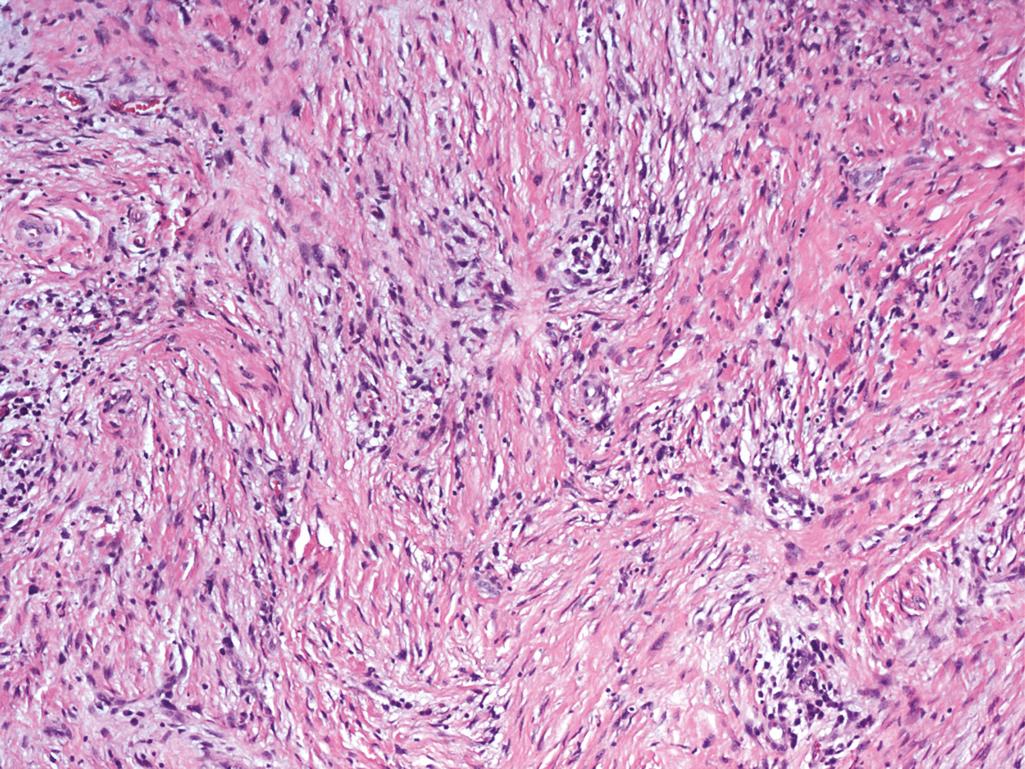
Background usually contains a sparse inflammatory component consisting of lymphocytes and plasma cells; eosinophils may also be numerous
Prominent network of thin-walled blood vessels in an edematous or myxoid stroma with little-to-moderate collagen deposition is common
Spindle cells may show focal pleomorphism
Mitotic figures may be present and even frequent, but they are not atypical
Infiltration into the muscularis propria may occur
ALK protein: positive in two thirds of cases
Cytokeratin: variable staining pattern
Smooth muscle actin (SMA): often positive
Desmin: typically negative
Translocation involving chromosome 2p23, site of the ALK gene
Consists of malignant epithelial and malignant mesenchymal components
Numerous mitotic figures
Lacks inflammatory background
Lacks network of thin-walled blood vessels
Overall, rare; however, it is the most common bladder sarcoma in older adults
Usually shows infiltrative margins
Typically shows cytologic atypia and increased mitotic activity with atypical mitotic figures
More commonly shows immunohistochemical evidence of smooth muscle differentiation
Benign spindle cell neoplasm; complete surgical resection is the treatment of choice
Most common misdiagnosis is that of malignant sarcoma or sarcomatoid carcinoma
Most inflammatory pseudotumors are pedunculated and extend into the bladder lumen; occasionally they may be sessile and infiltrative
Relatively common malignant neoplasm in children under the age of 15
Most common bladder tumor of childhood
Typically found before the age of 5
Slightly more common in boys (male-to-female ratio of 3:2)
Most tumors are of embryonal subtype and exophytic (polypoid), with or without a botryoid component
Rare in adults, usually of the pleomorphic type
Typically presents with hematuria or bladder outlet obstruction
Grossly, embryonal rhabdomyosarcoma can be divided into two basic forms with prognostic impact: polypoid, mostly intraluminal, associated with favorable prognosis (grapelike clusters, botryoid subtype); and deeply invasive tumors with a worse prognosis
Typically occurs at the bladder trigone
Tumor cells are small, round with scant cytoplasm, and hyperchromatic nuclei
Typically a loose myxoid background is seen
Large cells with abundant eosinophilic cytoplasm and cross-striations (strap cells) may be seen
Myogenin (myf4) and MyoD1: positive
Desmin and pan-actin (HHF35): positive, but not specific
Myosin and myoglobin: can be negative
Cytokeratin: negative
Electron microscopy: cells show thin actin and thick myosin filaments forming hexagonal pattern
Consists of malignant epithelial and malignant spindle cell components
Islands of cells with epithelial differentiation are seen
Cytokeratin positivity in the epithelial component
Background usually contains a sparse inflammatory component
Prominent network of thin-walled blood vessels in an edematous or myxoid stroma
Mitotic figures may be present and even frequent, but they are not atypical
ALK-1 protein expression
Treatment includes surgery, radiation therapy, and chemotherapy; combination therapy has greatly improved survival in the pediatric age group
Constitutes greater than 75% of bladder tumors in children
Most common mesenchymal tumor of the urinary bladder
Rare tumors of the urinary bladder
Primarily affects elderly adults (seventh and eighth decades)
Usually presents with hematuria or bladder outlet obstruction
May rarely involve the ureter, renal pelvis, and bladder diverticulum
Previous history of carcinoma treated by radiation or exposure to cyclophosphamide therapy is common
Typically large polypoid mass measuring up to 10 to 12 cm in diameter with infiltrative margins
Biphasic malignant neoplasm exhibiting morphologic or immunohistochemical evidence of epithelial and mesenchymal differentiation; presence or absence of heterologous elements should be mentioned in the diagnosis
Malignant epithelial component is composed of urothelial, glandular, or small cell component showing variable degree of differentiation
Mesenchymal component usually consists of pleomorphic, undifferentiated high-grade spindle cell neoplasm
Most common heterologous element is osteosarcoma followed by chondrosarcoma, rhabdomyosarcoma, leiomyosarcoma, liposarcoma
Cytokeratin (low molecular weight): epithelioid component is positive; some positivity in mesenchymal component may be seen
EMA may be positive but less frequently than cytokeratin
Vimentin: mesenchymal component is positive
SMA may be positive in areas of smooth or striated muscle differentiation
Noncontributory
Become a Clinical Tree membership for Full access and enjoy Unlimited articles
If you are a member. Log in here